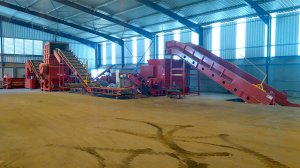Local waste management business Interwaste launched South Africa’s first refuse-derived-fuel (RDF) plant earlier this month, which creates fuel from nonrecyclable materials, such as plastic, thereby reducing waste to landfill.
“In line with global best practice, Interwaste continually invests in innovative solutions that have the most environmentally sound waste management [practices] at its core. It is with this in mind and with a strong focus on aiding our customers to reduce operational expenses, while acting responsibly towards the environment, that we commissioned the RDF plant,” Interwaste CEO Allan Willcocks said at the launch.
The plant, which was imported from China last year, is located at the company’s depot in Germiston, Gauteng, and is producing a solid recovered fuel in the form of extruded logs and pellets, as well as shredded and bailed fluff, to European standards.
The current plant, the first of four lines, is expected to convert at least 12 000 t/y of waste into alternative fuel for use in the South African manufacturing sector, helping to alleviate the country’s dependence on carbon-based electricity generation.
Interwaste technical services director Mike Nicholls explained that RDF involved the “combustible fraction of nonhazardous dry industrial and municipal waste, which [could] be extracted and used as fuel”.
He highlighted that Interwaste studied the European model for RDF, particularly in the UK, and it was found that South African waste disposal costs about R200/t, while it could cost as much as R2 000/t in the UK, owing to additional landfill taxes levied against companies.
Separation Equipment
To make RDF a feasible business venture, it became important for Interwaste to develop a plant that was significantly cheaper than those in Europe, which Nicholls noted could cost about R200-million, owing to specialised equipment – such as optical sorting, density and X-ray separation equipment – that the plants use.
The company addressed the challenge by expanding its on-site waste management division, which employs about 400 people on site at clients’ facilities. The division employs people to source and separate recoverable and recyclable materials at the source, and by employing more individuals at customers’ facilities to separate materials at the source, Interwaste reduced the capital costs of producing RDF by 80%.
Further, Nicholls highlighted that the fuel produced by Interwaste had, in some cases, double the calorific content of its European counterparts, which produced an RDF with a calorific content of between 16 MJ/kg and 18 MJ/kg; Interwaste’s best product achieved a calorific content of 31 MJ/kg.
He added that the RDF produced by Interwaste was also highly efficient, owing to its combustibility that resulted in all calorific energy being liberated in about three seconds, according to tests conducted by local research and development organisation Mintek.
RDF can be used to fuel a number of applications such as coal-fuelled power stations, gasification pyrolysis plants, RDF dedicated power stations and cement kilns.
Interwaste was partnering with the local cement industry, Nicholls pointed out, adding that cement kiln processes were ideal for RDF, owing to its ability to combust fuels derived from mixed materials.
Edited by: Martin Zhuwakinyu
Creamer Media Senior Deputy Editor
EMAIL THIS ARTICLE SAVE THIS ARTICLE
To subscribe email subscriptions@creamermedia.co.za or click here
To advertise email advertising@creamermedia.co.za or click here












